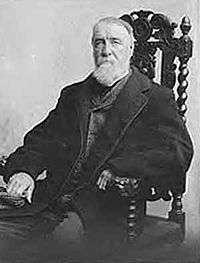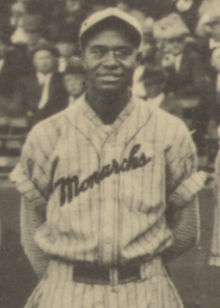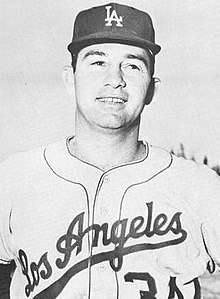Battery (baseball)
In baseball, the term battery refers collectively to the pitcher and the catcher, who may also be called batterymen[1] or batterymates of one another.
_and_catcher_Brayan_Pena_(27)_(5756979539).jpg)
History

The use of the word 'battery' in baseball was first coined by Henry Chadwick in the 1860s in reference to the firepower of a team's pitching staff and inspired by the artillery batteries then in use in the American Civil War.[2] Later, the term evolved to indicate the combined effectiveness of pitcher and catcher.[2]
Famous batteries

Some batteries are remarked upon as more than usually productive. Yogi Berra (catcher) and Whitey Ford (pitcher) were World-Series level players who were batterymates with the Yankees since Ford's rookie season in 1950.[3] They started 212 games together.[4][5]
In the early 20th century, some prominent pitchers were known to have picked their favorite catchers. Sportswriter Fred Lieb recalls the batteries of Christy Mathewson / Frank Bowerman beginning in 1899 with the New York Giants, Jack Coombs / Jack Lapp beginning in 1908 with the Philadelphia Athletics, Cy Young / Lou Criger gaining the greatest attention in 1901 with the Boston Americans (later the Red Sox), and Grover Cleveland Alexander / Bill Killefer beginning in 1911 with the Philadelphia Phillies.[6] Other successful batteries were Ed Walsh / Billy Sullivan beginning in 1904, along with Walter Johnson / Muddy Ruel and Dazzy Vance / Hank DeBerry both starting in 1923.[7][8][9]
Frank Duncan, Jr. and his son, Frank Duncan III, of the 1941 Kansas City Monarchs are thought to have been the first father-son battery in professional baseball history.[10][11]
In 1976, several major league pitchers chose their preferred catchers; a notion that had fallen out of practice for some decades. For instance, catcher Bob Boone of the Philadelphia Phillies, though one of the best catchers of his day, was replaced with Tim McCarver at the request of pitcher Steve Carlton. The Carlton/McCarver combination worked well in 32 out of Carlton's 35 games that season, plus one playoff game. The two had previously been batterymates for four years (1966-69) with the St. Louis Cardinals.[6] Another battery-by-choice was superstitious rookie pitcher Mark Fidrych who was new to the Detroit Tigers in 1976, insisting on rookie catcher Bruce Kimm behind the plate. The Fidrych/Kimm combination started all 29 of Fidrych's 1976 season games. The two continued as a battery through 1977.[6]
On July 13, 2014, pitcher Madison Bumgarner and catcher Buster Posey of the San Francisco Giants became MLB's first battery to hit grand slams in the same game against the Arizona Diamondbacks. It was Bumgarner's second grand slam of the season (April 11).[12]
The battery that appeared in the most games together was Mariano Rivera and Jorge Posada, with 598 games.[13] The battery that started the most games together is Mickey Lolich and Bill Freehan (324 games, for the 1963-1975 Detroit Tigers), followed by Warren Spahn and Del Crandall (316 games, for the 1949-1963 Boston and Milwaukee Braves), and Red Faber and Ray Schalk, (306 games, for the 1914-1926 Chicago White Sox).[14] Faber and Schalk had the most total innings together (2553.2).[15]
Lefty Grove (ranked by Bill James as the second-greatest pitcher of all time)[16] and Mickey Cochran (ranked by James as the eighth-greatest catcher)[17] started 224 games together for the 1925-1933 Philadelphia Athletics.[14]
Sibling batteries
The following chart of major league sibling batteries lists pitcher/catcher siblings who played on the same major league team during a single major league season. The pair may or may not have performed as a battery in an actual major league game.[18]
Unique among those listed below are Mort and Walker Cooper, who formed the National League's starting battery at both the 1942 and 1943 MLB All-Star Games, and also appeared as a battery in the 1942, 1943, and 1944 World Series, the only sibling battery to achieve either feat.
Further reading
- Long term battery combinations / 3,000 or more outs (1893–2017) at SeamHeads.com
See also
References
- "Battery (baseball) – Britannica Online Encyclopedia". Encyclopædia Britannica. Retrieved 2008-11-11.
- Edward Gruver. "Koufax". BaseballLibrary.com. Archived from the original on 2008-07-20. Retrieved 2008-11-11.
- Barra, Allen (2009). Yogi Berra: Eternal Yankee. W. W. Norton. p. 269. ISBN 0393062333.
- "Yogi Berra's Pitchers". Catcher's Battery Mates. Society for American Baseball Research. Retrieved October 20, 2012.
- "Whitey Ford's Battery Mates". Catching Hall Of Fame Pitchers. Society for American Baseball Research. Retrieved October 20, 2012.
- Grosshandler, Stan. "Pitcher's Choice". Research Journals Archive. Society for American Baseball Research. Archived from the original on September 26, 2018. Retrieved October 20, 2012.
-
- Billy Sullivan Sr. at the SABR Baseball Biography Project, by Trey Strecker, Retrieved November 20, 2011.
- "Muddy Rule New York Times obituary at thedeadballera.com". thedeadballera.com. Archived from the original on November 6, 2019. Retrieved May 8, 2018.
- "Hank DeBerry Dead". The Pittsburgh Post-Gazette. Associated Press. 11 September 1951. p. 14. Retrieved 8 May 2018.
- Chris Landers (June 7, 2016). "The little-known but awesome story of professional baseball's first father-son battery". mlb.com. Retrieved January 9, 2020.
- Ryan Whirty (February 11, 2016). "Seventy five years ago, father-son battery made baseball history with Kansas City Monarchs". kansascity.com. Retrieved January 9, 2020.
- Pavlovic, Alex. "Giants' battery of Bumgarner, Posey provide charge heading to All-Star break". San Jose Mercury News. Retrieved March 7, 2019.
- Dan Holmes (December 26, 2018). "The greatest batteries in baseball history". Baseball Egg. Retrieved April 29, 2020.
- Doug (January 28, 2016). "200 Game Batteries". High Heat Stats. Retrieved April 29, 2020.
- Kevin Johnson (April 24, 2018). "Long-Term Battery Combinations". Seamheads.com. Retrieved April 29, 2020.
- David Schoenfield (December 13, 2012). "Hall of 100: Best pitcher of all time". ESPN. Retrieved April 29, 2020.
- Bill James (December 14, 2017). "Catchers of the Last 40 years". Bill James Online. Retrieved April 29, 2020.
- Larry Amman and L. Robert Davids. "Baseball Brothers". Society for American Baseball Research. Retrieved January 9, 2020.


